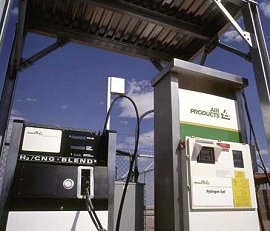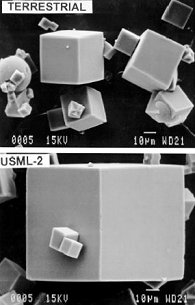Imagine pulling up to a filling station, inserting the nozzle into the tank and the gas flowing into your tank is ... hydrogen.

It's colorless, odorless and the byproduct of burning hydrogen is water vapor, quickly and safely absorbed by the environment. One pound of hydrogen supplies three times as much energy as a pound of gasoline. And it's the most plentiful element in the universe!
No wonder scientists are trying to figure out how to make hydrogen work as a practical fuel.
"Dozens of companies, including all the major automobile manufacturers, have designed engines that burn hydrogen -- they're a lot like the internal combustion engines we have in cars today," says Al Sacco, director of the NASA-supported Center for Advanced Microgravity Materials Processing (CAMMP) at Northeastern University in Boston. "Fuel cells -- another possible source of power for cars -- use hydrogen, too. To make these technologies work in the real world, scientists must find a way to store and transport hydrogen safely at a cost comparable to that of gasoline."
It's not easy: Hydrogen gas is light and elusive. Tiny H2 molecules like to sneak through cracks and seals -- and once free they quickly disperse. Hydrogen diffuses four times faster than methane and ten times faster than gasoline vapors. This is great for safety because a leak is quickly diluted and rendered harmless. It's a headache for anyone who wants to store the gas.
Liquid hydrogen is more compact and easier to contain, but it can be troublesome, too. Liquid hydrogen is actually cold enough to freeze air. This could cause plugged valves and unwanted pressure build-ups. Insulation to prevent such problems adds to the weight of the storage system.
How can we overcome these obstacles? Simple: put rocks in your gas tank.
Not ordinary rocks. Zeolites. Sacco explains: "Zeolites are porous, rocky substances that act like molecular sponges. In their crystalline form, zeolites are threaded by a network of interconnected tunnels and cages, similar to a honeycomb." A fuel tank lined with such crystals might be able to trap and store hydrogen gas "in a liquid-like state -- without heavy cryogenics."
With support from NASA's Space Product Development program at the Marshall Space Flight Center, Sacco and colleagues at CAMMP are working to make zeolite gas tanks a reality.
"If we can grow zeolite crystals that hold 6% to 7% of their own weight in hydrogen," says Sacco, "then a zeolite tankful of hydrogen would be competitive with an ordinary tankful of gasoline." The best existing zeolites can hold only 2% to 3%, however.
In 1995, Sacco traveled to space as a mission specialist onboard the space shuttle Columbia (STS-73). His purpose: to grow better zeolite crystals. "In low-gravity, materials come together more slowly, allowing zeolite crystals to form that are both larger and more orderly." Zeolite crystals produced on Earth are small, roughly 2 to 8 microns across. "That's about one-tenth the thickness of a human hair." The ones he grew on the space shuttle were not only 10 times bigger, but also better organized internally -- a promising start.

"The next step is the International Space Station," says Sacco. He and others at CAMMP have built a Zeolite Crystal Growth Furnace, which was installed on the ISS in early 2002. "Ken Bowersox, the ISS Expedition 6 commander, has used the furnace to grow some crystals for us. Ken had to correct some unexpected problems with the mixing of the crystal growth solution--this shows the values of humans in space -- but after that the experiment went smoothly."
"Now we need to get those crystals back to Earth where we can examine them. A few might come down in May," when the Expedition 6 crew leaves the ISS in an Soyuz capsule. "I'd really like to see them," says Sacco.
The goal, he says, is not to mass produce zeolite crystals in space. That's not economical -- at least not yet. "We simply want to find out if it's possible to grow zeolite crystals that can reach the 7% threshold. If we can do that in space, we'll figure out how to reproduce the process on the ground."
Throughout his career, Sacco has envisioned a worldwide transition from fossil to hydrogen fuels. It's a big dream, but it could happen. "Zeolites may be the key to hydrogen fuel as a leapfrog technology."
Coming soon -- a hydrogen fueling station near you?
Marshall Space Flight Center